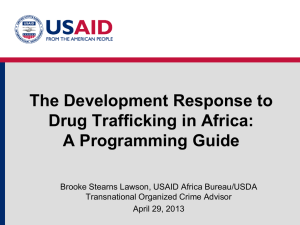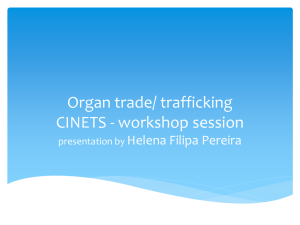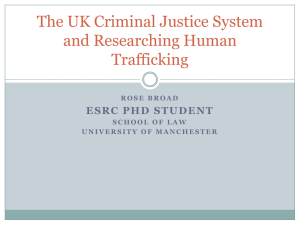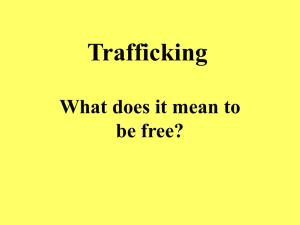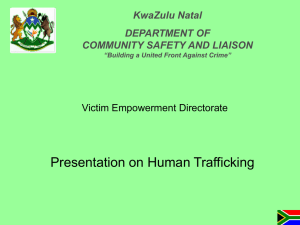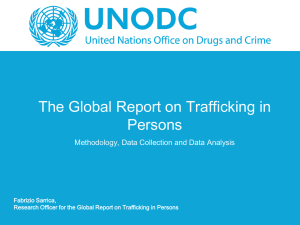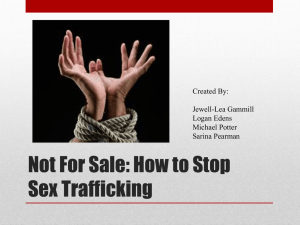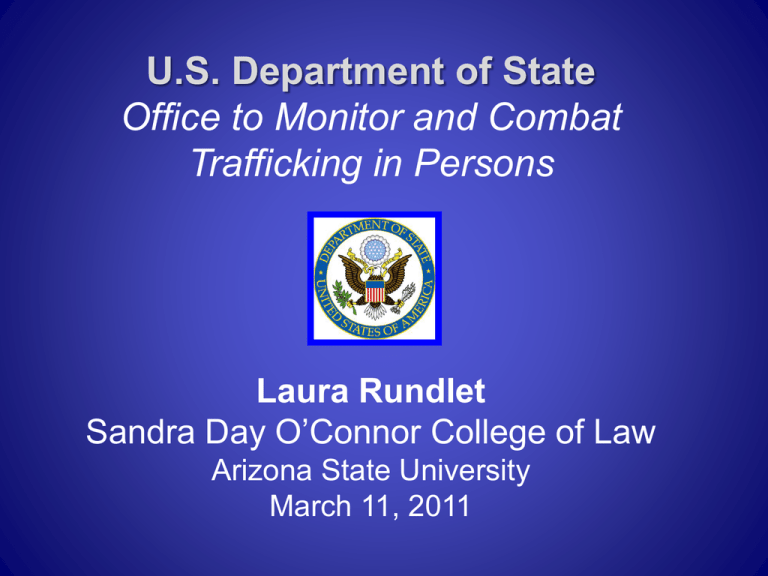
U.S. Department of State
Office to Monitor and Combat
Trafficking in Persons
Laura Rundlet
Sandra Day O’Connor College of Law
Arizona State University
March 11, 2011
What Does the Department of State Do to
Combat Human Trafficking?
The Office to Combat and Monitor Trafficking in Persons
was created by the Trafficking Victims Protection Act of
2000 (TVPA).
Produces the annual Trafficking in Persons Report
Chairs the President’s Interagency Task Force to Monitor
and Combat Trafficking, created by TVPA to coordinate
U.S. government policy, programs and planning
Funds and monitors anti-human trafficking programs
overseas
Encourages cooperation through face-to-face diplomacy
Engages in public diplomacy and raises public awareness
U.S. and Int’l Trafficking Laws
• The Trafficking Victims Protection Act
(TVPA), passed with bipartisan support and
signed into law by President Clinton in 2000
• The UN Protocol to Prevent, Suppress and
Punish Trafficking in Persons, especially
Women and Children (Palermo Protocol),
adopted in Palermo, Italy in 2000 and entered
into force in 2003
Palermo Protocol Definition of TIP
• “Trafficking in persons” shall mean the recruitment,
transportation, transfer, harbouring or receipt of
persons, by means of the threat or use of force or
other forms of coercion, of abduction, of fraud, of
deception, of the abuse of power or of a position of
vulnerability or of the giving or receiving of
payments or benefits to achieve the consent of a
person having control over another person, for the
purpose of exploitation. Exploitation shall include, at
a minimum, the exploitation of the prostitution of
others or other forms of sexual exploitation, forced
labour or services, slavery or practices similar to
slavery, servitude or the removal of organs;
TVPA Definition of TIP
• SEVERE FORMS OF TRAFFICKING IN PERSONS—The
term ‘severe forms of trafficking in persons’ means—
(A) sex trafficking [the recruitment, harboring, transportation,
provision, or obtaining of a person for the purpose of a
commercial sex act] in which a commercial sex act is induced
by force, fraud, or coercion, or in which the person induced to
perform such act has not attained 18 years of age; or
(B) the recruitment, harboring, transportation, provision, or
obtaining of a person for labor or services, through the use of
force, fraud, or coercion for the purpose of subjection to
involuntary servitude, peonage, debt bondage, or slavery.
Growing Global Consensus
• Modern slavery is generally defined as a set of acts, means and purposes:
Acts: recruiting, harboring, transporting, obtaining
Means: using force, fraud or coercion
Purposes: involuntary servitude, debt bondage, slavery or commercial sex
• There are between 12 and 27 million slaves in the world today.
• Victims of human trafficking can be men, women, or children; citizens
or non-citizens, with or without legal status.
• Trafficking in persons does not need to involve movement across
international boundaries.
• Trafficking in persons takes many forms:
• Forced Labor
• Bonded Labor
• Sex Trafficking
• Debt Bondage among Migrant
Laborers
• Involuntary Domestic Servitude
• Forced Child Labor
• Child Soldiers
• Child Sex Trafficking
The Three “P” Approach
Prosecution:
- Prosecute traffickers
- Pass anti-trafficking legislation
Protection:
- Identify victims and protect them
- Assist victims
- Encourage government-NGO cooperation
Prevention:
- Public awareness
- Training police, first-responders
- Discourage demand
The 4 Minimum Standards
• First Standard: The government of the country
should prohibit severe forms of trafficking in persons
and punish acts of such trafficking.
• Second Standard: For the knowing commission of
any act of sex trafficking involving force, fraud,
coercion, or in which the victim of sex trafficking is
a child incapable of giving meaningful consent, or of
trafficking which includes rape or kidnapping or
which causes a death, the government of the country
should prescribe punishment commensurate with that
for grave crimes, such as forcible sexual assault.
The 4 Minimum Standards
• Third Standard: For the knowing commission
of any act of a severe form of trafficking in
persons, the government of the country should
prescribe punishment that is sufficiently stringent
to deter and that adequately reflects the heinous
nature of the offense.
• Fourth Standard: The government of the
country should make serious and sustained efforts
to eliminate severe forms of trafficking in
persons.
Tier Rankings
(2010 TIP Report)
• Tier 1 (30 countries)
• Tier 2 (74 countries)
• Tier 2 Watch List (58 countries)
• Tier 3 (13 countries)
Examples of Positive Impact
of TIP Assessments
•Enacting new anti-TIP
laws or laws focused on
particular problems
•Reducing numbers of
victims or increasing
numbers rescued
•Addressing government
complicity or corruption
•Forming a national task
force or naming a “czar”
Automatic Downgrade
Section 107(a) of the 2008 reauthorization of
the TVPA requires that any country included
on the Special Watch List (Tier 2) for two
consecutive years be automatically listed in
the following year’s report on the so-called
Tier 3 List of countries whose governments do
not fully comply with the Minimum Standards
for the elimination of trafficking and are not
making significant efforts to do so.
U.S. Government Interagency Coordination
• President’s Interagency Task Force to Monitor and Combat
Trafficking (PITF)
• Department of State
• Department of Defense
• Department of Justice
• Department of the Interior
• Department of Agriculture
• Department of Labor
• Department of Education
• Department of Health and Human Services
• Department of Homeland Security
• Office of Management and Budget
• Office of the Director of National Intelligence
• Federal Bureau of Investigation
• U.S. Agency for International Development
• Equal Employment Opportunity Commission
• Senior Policy Operating Group (SPOG)
Photos from the 2011 PITF Meeting, February 1,2011
A Decade Later…
• Increased convictions worldwide
– 40 percent increase: from 2,983 in 2009 to 4,166 in
2010
• As of the last TIP Report, 116 countries have
enacted legislation prohibiting all forms of TIP
• In the last year, 33 countries have enacted antiTIP legislation, 7 of them comprehensive antiTIP laws


